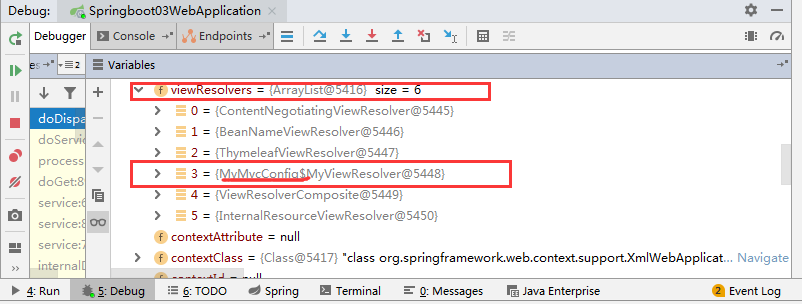SpringBoot-Mvc自动装配的原理-08
MVC自动配置的原理
1. 官方文档翻译
Spring MVC Auto-configuration
// Spring Boot为Spring MVC提供了自动配置,它可以很好地与大多数应用程序一起工作。
Spring Boot provides auto-configuration for Spring MVC that works well with most applications.
// 自动配置在Spring默认设置的基础上添加了以下功能:
The auto-configuration adds the following features on top of Spring’s defaults:
// 包含视图解析器
Inclusion of ContentNegotiatingViewResolver and BeanNameViewResolver beans.
// 支持静态资源文件夹的路径,以及webjars
Support for serving static resources, including support for WebJars
// 自动注册了Converter:
// 转换器,这就是我们网页提交数据到后台自动封装成为对象的东西,比如把"1"字符串自动转换为int类型
// Formatter:【格式化器,比如页面给我们了一个2019-8-10,它会给我们自动格式化为Date对象】
Automatic registration of Converter, GenericConverter, and Formatter beans.
// HttpMessageConverters
// SpringMVC用来转换Http请求和响应的的,比如我们要把一个User对象转换为JSON字符串,可以去看官网文档解释;
Support for HttpMessageConverters (covered later in this document).
// 定义错误代码生成规则的
Automatic registration of MessageCodesResolver (covered later in this document).
// 首页定制
Static index.html support.
// 图标定制
Custom Favicon support (covered later in this document).
// 初始化数据绑定器:帮我们把请求数据绑定到JavaBean中!
Automatic use of a ConfigurableWebBindingInitializer bean (covered later in this document).
/*
如果您希望保留Spring Boot MVC功能,并且希望添加其他MVC配置(拦截器、格式化程序、视图控制器和其他功能),则可以添加自己
的@configuration类,类型为webmvcconfiguer,但不添加@EnableWebMvc。如果希望提供
RequestMappingHandlerMapping、RequestMappingHandlerAdapter或ExceptionHandlerExceptionResolver的自定义
实例,则可以声明WebMVCregistrationAdapter实例来提供此类组件。
*/
If you want to keep Spring Boot MVC features and you want to add additional MVC configuration
(interceptors, formatters, view controllers, and other features), you can add your own
@Configuration class of type WebMvcConfigurer but without @EnableWebMvc. If you wish to provide
custom instances of RequestMappingHandlerMapping, RequestMappingHandlerAdapter, or
ExceptionHandlerExceptionResolver, you can declare a WebMvcRegistrationsAdapter instance to provide such components.
// 如果您想完全控制Spring MVC,可以添加自己的@Configuration,并用@EnableWebMvc进行注释。
If you want to take complete control of Spring MVC, you can add your own @Configuration annotated with @EnableWebMvc.
2. ContentNegotiatingViewResolver内容视图解析器
- 自动配置了ViewResolver,就是之前的SpringMVC的视图解析器(加前缀后缀那个)
- 根据方法返回值取得视图对象,然后由视图对象决定如何渲染(转发,重定向)
看源码:找到WebMvcAutoConfigurarion,然后搜索ContentNegotiatingViewResolver找到如下的方法
public ContentNegotiatingViewResolver viewResolver(BeanFactory beanFactory) {
ContentNegotiatingViewResolver resolver = new ContentNegotiatingViewResolver();
resolver.setContentNegotiationManager((ContentNegotiationManager)beanFactory.getBean(ContentNegotiationManager.class));
// ContentNegotiatingViewResolver使用所有其他视图解析器来定位视图,因此它应该具有较高的优先级
resolver.setOrder(-2147483648);
return resolver;
}
进入这个类之后找到对应的解析视图代码
public View resolveViewName(String viewName, Locale locale) throws Exception {
RequestAttributes attrs = RequestContextHolder.getRequestAttributes();
Assert.state(attrs instanceof ServletRequestAttributes, "No current ServletRequestAttributes");
List<MediaType> requestedMediaTypes = this.getMediaTypes(((ServletRequestAttributes)attrs).getRequest());
if (requestedMediaTypes != null) {
//获取候选的视图对象
List<View> candidateViews = this.getCandidateViews(viewName, locale, requestedMediaTypes);
//选择合适的视图对象然后把这个对象返回
View bestView = this.getBestView(candidateViews, requestedMediaTypes, attrs);
if (bestView != null) {
return bestView;
}
}
String mediaTypeInfo = this.logger.isDebugEnabled() && requestedMediaTypes != null ? " given " + requestedMediaTypes.toString() : "";
if (this.useNotAcceptableStatusCode) {
if (this.logger.isDebugEnabled()) {
this.logger.debug("Using 406 NOT_ACCEPTABLE" + mediaTypeInfo);
}
return NOT_ACCEPTABLE_VIEW;
} else {
this.logger.debug("View remains unresolved" + mediaTypeInfo);
return null;
}
}
进入这个方法接着看,看是如何获取到的候选视图对象
private List<View> getCandidateViews(String viewName, Locale locale, List<MediaType> requestedMediaTypes) throws Exception {
List<View> candidateViews = new ArrayList();
if (this.viewResolvers != null) {
Assert.state(this.contentNegotiationManager != null, "No ContentNegotiationManager set");
Iterator var5 = this.viewResolvers.iterator();
while(var5.hasNext()) {
ViewResolver viewResolver = (ViewResolver)var5.next();
View view = viewResolver.resolveViewName(viewName, locale);
if (view != null) {
candidateViews.add(view);
}
Iterator var8 = requestedMediaTypes.iterator();
while(var8.hasNext()) {
MediaType requestedMediaType = (MediaType)var8.next();
List<String> extensions = this.contentNegotiationManager.resolveFileExtensions(requestedMediaType);
Iterator var11 = extensions.iterator();
while(var11.hasNext()) {
String extension = (String)var11.next();
String viewNameWithExtension = viewName + '.' + extension;
view = viewResolver.resolveViewName(viewNameWithExtension, locale);
if (view != null) {
candidateViews.add(view);
}
}
}
}
}
if (!CollectionUtils.isEmpty(this.defaultViews)) {
candidateViews.addAll(this.defaultViews);
}
return candidateViews;
}
getCandidateViews中看到是吧所有的视图解析器拿来,进行的while循环,挨个解析
Iterator var5 = this.viewResolvers.iterator();
得出的结论是ContentNegotiatingViewResolver这个视图解析器就是用来组合所有的视图解析器的
接着看一个属性viewResolvers,看在哪里进行赋值
private List<View> getCandidateViews(String viewName, Locale locale, List<MediaType> requestedMediaTypes) throws Exception {
//这是他从bean工厂中获取容器中的所有视图解析器
//viewResolver.class把所有的视图解析器来组合的
List<View> candidateViews = new ArrayList();
if (this.viewResolvers != null) {
Assert.state(this.contentNegotiationManager != null, "No ContentNegotiationManager set");
Iterator var5 = this.viewResolvers.iterator();
}
....
}
猜想:是否可以自己实现一个视图解析器
3. 给自己的容器中添加一个视图解析器
- 我们在我们的主程序中写一个视图解析器
//扩展 springmvc DispatchServlet
@Configuration
public class MyMvcConfig implements WebMvcConfigurer {
// public interface ViewResolver 实现了视图解析器接口的类,我们就可以吧它看做视图解析器
@Bean
public ViewResolver myViewResolver() {
return new MyViewResolver();
}
// 自定义了一个自己的视图解析器
public static class MyViewResolver implements ViewResolver {
@Override
public View resolveViewName(String s, Locale locale) throws Exception {
return null;
}
}
}
- 如何看自己的视图解析器生效了没?
给DispatcherServlet中的doDispatch方法加断点,
启动项目之后访问页面,看一下Debug信息
找到this然后找到viewResolvers

- 想要定制的话,只需要给这个容器中添加这个组件就好,剩下的事情SpringBoot就会帮我们做
4.转换器和格式转化器
@Bean
@Override
public FormattingConversionService mvcConversionService() {
// 拿到配置文件中的格式化规则
WebConversionService conversionService = new WebConversionService(this.mvcProperties.getDateFormat());
addFormatters(conversionService);
return conversionService;
}
点进去可以看到在我们的Properties文件中,我们可以自动配置
public String getDateFormat() {
return this.dateFormat;
}
/**
* Date format to use. For instance, `dd/MM/yyyy`. 默认的
*/
private String dateFormat;
可以看到Properties文件中,我们可以自动配置
如果配置了自己的格式化方式,就会注册到Bean中生效,我们可以在配置文件中配置日期格式化的规则
spring.mvc.date-format
源码
public void setDateFormat(String dateFormat) {
this.dateFormat = dateFormat;
}```
> 修改SpringBoot的默认配置
- SpringBoot在自动配置很多组件的时候,先看容器中有没有用户自己配置的(如果用户自己配置@bean),如果有就用用户配置的,如果没有就用自动配置的;
- 如果有些组件可以存在多个,比如我们的视图解析器,就将用户配置的和自己默认的组合起来!
**扩展使用SpringMVC官方文档**
1. 编写一个@Configuration注解类,并且类型要为WebMvcConfigurer,还不能标注@EnableWebMvc注解;我们去自己写一个;
2. 新建一个包叫config,写一个MyMvcconfig
```java
// 如果我们要扩展springmvc,官方建议我们这样去做@Configuration
//应为类型要求为WebMvcConfigurer,所以我们实现其接口
//扩展 springmvc DispatchServlet
//@EnableWebMvc //就是导入了一个类,DelegatingWebMvcConfiguration,从容器中获取所有的webMvcConfig
@Configuration
public class MyMvcConfig implements WebMvcConfigurer {
@Override
public void addViewControllers(ViewControllerRegistry registry) {
// 浏览器发送/test2 , 就会跳转到test页面;
registry.addViewController("/test2").setViewName("test");
}
}
确实也跳转过来了!所以说,我们要扩展SpringMVC,官方就推荐我们这么去使用,既保SpringBoot留所有的自动配置,也能用我们扩展的配置!
1. 分析原理
-
WebMvcAutoConfiguration 是 SpringMVC的自动配置类,里面有一个类WebMvcAutoConfigurationAdapter
-
这个类上有一个注解,在做其他自动配置时会导入:@Import(EnableWebMvcConfiguration.class)
-
我们点进EnableWebMvcConfiguration这个类看一下,它继承了一个父类:DelegatingWebMvcConfiguration
这个父类中有这样一段代码:
public class DelegatingWebMvcConfiguration extends WebMvcConfigurationSupport {
private final WebMvcConfigurerComposite configurers = new WebMvcConfigurerComposite();
// 从容器中获取所有的webmvcConfigurer
@Autowired(required = false)
public void setConfigurers(List<WebMvcConfigurer> configurers) {
if (!CollectionUtils.isEmpty(configurers)) {
this.configurers.addWebMvcConfigurers(configurers);
}
}
}
- 我们可以在这个类中去寻找一个我们刚才设置的viewController发现他调用了一个
protected void addViewControllers(ViewControllerRegistry registry) {
this.configurers.addViewControllers(registry);
}
5.进去去看一下
public void addViewControllers(ViewControllerRegistry registry) {
Iterator var2 = this.delegates.iterator();
while(var2.hasNext()) {
// 将所有的WebMvcConfigurer相关配置来一起调用!包括我们自己配置的和Spring给我们配置的
WebMvcConfigurer delegate = (WebMvcConfigurer)var2.next();
delegate.addViewControllers(registry);
}
}
得出结论:所有的WebMvcConfiguration都会被作用,不止Spring自己的配置类,我们自己的配置类当然也会被调用;






 浙公网安备 33010602011771号
浙公网安备 33010602011771号